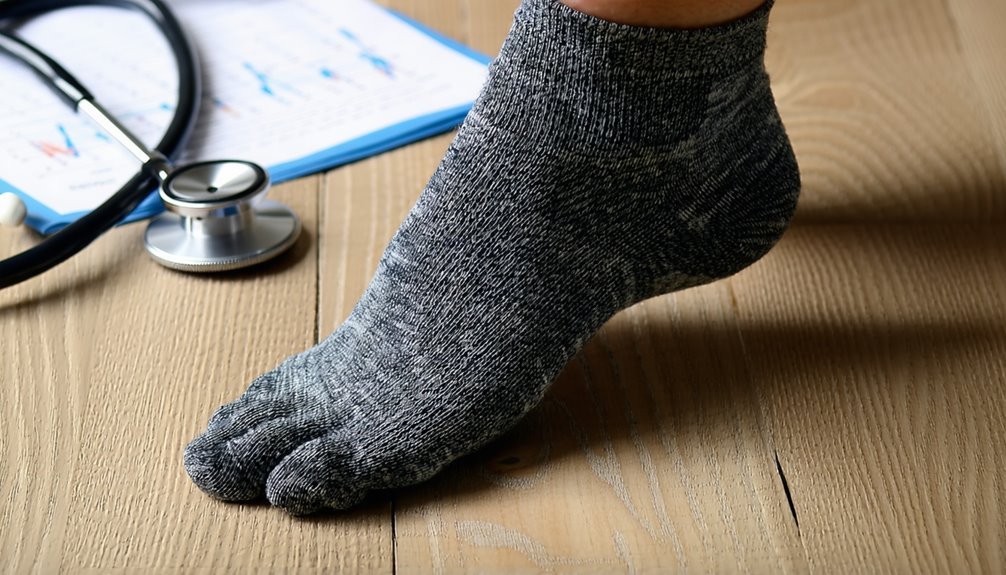Can Compression Socks Make Neuropathy Worse?
Compression socks can worsen neuropathy if not fitted correctly, as overly tight socks may impair circulation and exacerbate your symptoms. This is especially concerning for those with reduced sensation, where unnoticed injuries can occur. Proper fitting is essential, with low to moderate compression levels often recommended for neuropathy sufferers. Regular consultation with healthcare providers guarantees they're safe and effective in your care plan. Discovering the right fit can help manage symptoms effectively and foster better outcomes.
Understanding Neuropathy and Its Symptoms

Neuropathy, although often overlooked, is a condition that considerably impacts daily life by affecting the peripheral nerves. It disrupts nerve function, which can lead to symptoms like tingling, numbness, and discomfort. These symptoms may become overwhelming, making it essential to focus on effective symptom management. By understanding neuropathy, you can better identify signs early and seek appropriate care, minimizing progression. Clinical evidence suggests that addressing underlying causes and adopting a thorough management plan can enhance your safety and well-being. Prioritizing strategies such as medication, lifestyle changes, and regular monitoring can help maintain nerve function. It's vital to consult healthcare providers who can offer personalized advice, ensuring you manage neuropathy symptoms effectively and maintain a safe, comfortable lifestyle.
How Compression Socks Work
When considering compression socks for neuropathy, it's important to understand how they work to improve your condition. By applying gentle pressure to your legs, these socks enhance circulation, which can reduce swelling and discomfort. The design and material are vital, as they guarantee the right compression level and comfort for effective symptom management.
Compression Sock Mechanics
Understanding the mechanics of compression socks is essential for anyone seeking relief from neuropathy symptoms. These socks are designed to enhance comfort and promote health through specific mechanisms. First, you need to know about compression sock types. There are various kinds, such as graduated, anti-embolism, and non-medical support hose, each with unique applications. Second, they work by applying pressure gradients on your legs. This pressure is highest at the ankle and gradually decreases as it moves up the leg. Here's how they help:
- Boost blood flow: Enhances circulation to reduce swelling.
- Support veins: Helps in maintaining vein structure.
- Reduce pain: Alleviates discomfort associated with neuropathy.
- Prevent clotting: Lowers the risk of deep vein thrombosis.
Always consult your healthcare provider to guarantee safety.
Circulation and Pressure Effects
Although often overlooked, the role of circulation and pressure effects is vital in understanding how compression socks benefit those with neuropathy. By applying graduated pressure, compression socks enhance blood flow, which can be particularly advantageous if you're experiencing impaired circulation. Improved circulation helps in delivering oxygen and nutrients to tissues, potentially alleviating symptoms associated with neuropathy.
However, it's important to take into account nerve sensitivity. If your nerves are overly sensitive, compression might initially feel uncomfortable. Consulting with a healthcare provider guarantees the right pressure level is selected, minimizing discomfort while maximizing benefit. Properly fitted compression socks can therefore be a safe option to support blood flow and manage nerve sensitivity, contributing to overall comfort and well-being.
Material and Design Considerations
Choosing the right material and design for compression socks is fundamental to their effectiveness, particularly for those managing neuropathy. You need to take into account fabric choices that maximize comfort and minimize irritation. Look for:
- Breathable Materials: Opt for fabrics like cotton or bamboo to reduce moisture and prevent skin breakdown.
- Seamless Design: Seamless socks can decrease the risk of pressure points, which is essential for sensitive neuropathic feet.
- Graduated Compression: Confirm the socks offer graduated compression to enhance circulation without excessive pressure.
- Proper Fit: A snug but not tight fit helps avoid constriction, promoting safety and comfort.
These design features are critical to guarantee compression socks provide support without exacerbating neuropathic symptoms.
The Potential Benefits of Compression Socks for Circulation
For individuals experiencing neuropathy, compression socks can offer significant benefits by enhancing circulation. These specially designed socks apply gentle pressure to your legs, which aids in blood flow improvement and reduces swelling. Clinical studies suggest that the compression benefits include increased venous return, which can be essential for minimizing symptoms associated with neuropathy. By promoting circulation improvement, these socks help guarantee oxygen-rich blood reaches your extremities more efficiently, potentially alleviating discomfort and preventing complications.
It's important to select the right level of compression, ideally under professional guidance, to guarantee safety and effectiveness. Remember, the goal is to support your health by optimizing circulation without compromising comfort. Always consult with your healthcare provider before incorporating compression socks into your routine to tailor the approach to your specific needs.
The Risks of Applying Compression to Neuropathic Limbs

When considering compression socks for neuropathic limbs, it's essential to recognize the risks of impaired blood circulation, which can exacerbate symptoms. Applying compression incorrectly may also lead to potential nerve damage, further complicating your condition. Consulting with a healthcare professional guarantees that any compression therapy aligns with your specific needs and minimizes these risks.
Impaired Blood Circulation Risk
Although compression socks are often touted for their benefits in improving circulation and reducing swelling, applying compression to neuropathic limbs can pose significant risks. For those with neuropathy, these socks may lead to impaired circulation, negatively affecting blood flow to the extremities. It's essential to be aware of potential issues:
- Reduced Circulation: Compression might constrict blood vessels, reducing blood flow and exacerbating symptoms.
- Swelling Risks: Instead of alleviating swelling, improper use can cause fluid buildup.
- Skin Integrity: Tight socks can lead to skin breakdown, especially in those with sensory deficits.
- Cold Extremities: Restricted blood flow may cause limbs to feel cold, indicating impaired circulation.
Consult a healthcare provider to determine if compression socks are safe for your condition.
Potential Nerve Damage Concerns
Even though compression socks are widely used for their therapeutic benefits, there's a real risk they might exacerbate nerve damage in individuals with neuropathy. If you've got neuropathy, your nerves are already compromised, making them vulnerable to additional injury risks. Compression socks can apply pressure that might lead to nerve compression, further impairing sensation and potentially worsening your condition. Clinical evidence suggests that excessive pressure on already delicate nerves can intensify discomfort and lead to more severe complications.
To prioritize your safety, verify that any compression wear fits properly and doesn't constrict your limbs excessively. Always consult with a healthcare professional before using compression socks, especially if you're managing neuropathy, to tailor an approach that minimizes potential harm to your nerves.
Identifying Types of Neuropathy Affected by Compression

Understanding which types of neuropathy are most affected by compression is vital for tailoring effective treatment strategies. Compression socks can have varying effects depending on neuropathy types like diabetic neuropathy and peripheral neuropathy. Here are four types of neuropathy to watch out for:
Compression sock effects vary across neuropathy types; understanding this is key to effective treatment strategies.
- Diabetic Neuropathy: Compression may exacerbate symptoms if blood flow is compromised.
- Peripheral Neuropathy: Those with reduced sensation in extremities should be cautious, as compression can lead to unnoticed injuries.
- Autonomic Neuropathy: While not directly affected by compression, it's important to guarantee proper circulation.
- Focal Neuropathy: Localized nerve issues may worsen with improper pressure.
Balancing Pressure: Finding the Right Fit
How can you guarantee the compression socks you're using effectively balance pressure? Start with a thorough fit assessment. It's important to measure your leg dimensions accurately, considering both length and circumference, to prevent any adverse effects associated with improper sizing. Compression levels are equally significant; they range from mild to extra firm. For those with neuropathy, low to moderate compression levels are often recommended to promote safety and comfort. You should consult with a healthcare provider to tailor compression levels to your specific needs. Remember, too tight can exacerbate symptoms, while too loose may offer inadequate support. Prioritize a snug fit that distributes pressure evenly, making sure your socks aid circulation without increasing discomfort or risking further nerve damage.
Expert Opinions on Compression Socks and Neuropathy
While opinions on compression socks for neuropathy may vary among experts, there's a consensus on the importance of individualized care. Compression therapy can be beneficial, but it's essential to tailor it to your specific needs for effective neuropathy management. Experts recommend the following considerations to guarantee safety and efficacy:
Individualized care is key in compression therapy for neuropathy to ensure effective management and safety.
- Consult a healthcare provider: Before starting compression therapy, talk to a specialist to assess your condition.
- Monitor symptoms: Regularly check for any changes in your neuropathy symptoms to adjust treatment as needed.
- Proper fit and pressure: Confirm compression socks are the correct size and pressure level to avoid discomfort.
- Ongoing evaluation: Regular follow-ups with your healthcare provider can help refine your neuropathy management plan.
Prioritize your safety and well-being by following expert advice.
Alternative Solutions for Managing Neuropathy
Although compression therapy is a common approach for neuropathy, it's not the only avenue for relief. You might explore acupuncture therapy, which some studies suggest can improve nerve function by increasing blood flow and reducing pain. This ancient practice offers a complementary option with a growing body of evidence supporting its benefits for neuropathy management.
Additionally, herbal remedies can be a safe alternative. Ingredients like evening primrose oil and capsaicin are known for their anti-inflammatory properties, potentially easing neuropathic pain. However, it's essential to approach these remedies with caution, ensuring they're sourced from reputable suppliers.
Personalizing Treatment: Consulting With Healthcare Professionals
To effectively manage neuropathy, partnering with healthcare professionals is essential for tailoring treatments to your unique needs. Through patient experiences and healthcare collaboration, you can create a personalized plan that prioritizes safety and efficacy. Here's how consulting with professionals can help:
- Assessment: They'll evaluate your symptoms and medical history for a thorough understanding.
- Treatment Options: Discuss various treatments, including medications and lifestyle changes, to find what suits you best.
- Monitoring: Regular check-ins guarantee the treatment's effectiveness and address any concerns promptly.
- Education: Gain insights into neuropathy and self-care strategies to empower you in managing your condition.
Frequently Asked Questions
Can Compression Socks Help With Diabetic Neuropathy Specifically?
You're considering compression socks for diabetic neuropathy. They can improve circulation, offering neuropathy benefits, if used correctly. Consult your healthcare provider to ascertain they're safe and appropriate for your condition, focusing on diabetic circulation and tailored medical advice.
Do Compression Socks Affect Medication Absorption for Neuropathy?
Imagine your medication as a river flowing through your body. Compression socks won't dam that flow, so they don't affect medication interactions or absorption rates. Clinical evidence shows they're generally safe, but always consult your healthcare provider.
Are There Specific Brands of Compression Socks Recommended for Neuropathy?
You're considering compression socks for neuropathy. Focus on compression levels and brand comparisons. Seek evidence-based recommendations from clinical experts. Brands like Sigvaris and Jobst offer various options. Prioritize your safety by consulting healthcare providers for personalized advice.
How Often Should Compression Socks Be Worn for Neuropathy Relief?
You should wear compression socks daily, but ascertain they're the right compression level for your condition. Choose breathable, moisture-wicking sock materials to prevent irritation. Consult your healthcare provider for personalized advice, guaranteeing your comfort and safety.
Can Wearing Compression Socks Overnight Worsen Neuropathy Symptoms?
Wearing compression socks overnight might exacerbate neuropathy symptoms due to nighttime discomfort and circulation concerns. It's essential to consult your healthcare provider for advice tailored to your condition, ensuring both safety and effective symptom management.







